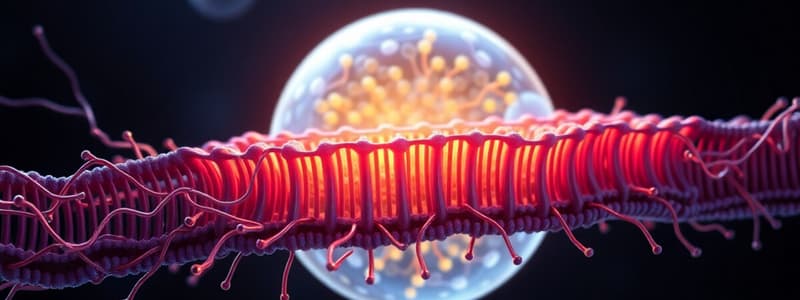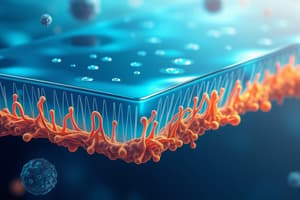Podcast
Questions and Answers
What is the primary difference between local potentials and action potentials?
What is the primary difference between local potentials and action potentials?
- Local potentials vary in magnitude whereas action potentials are all-or-none. (correct)
- Local potentials are always excitatory while action potentials can be either.
- Local potentials are irreversible, but action potentials are reversible.
- Local potentials occur without ion channel activity, unlike action potentials.
What is the role of Na+ ions in triggering an action potential?
What is the role of Na+ ions in triggering an action potential?
- They lead to a rapid depolarization of the membrane. (correct)
- They stimulate the closing of voltage-gated K+ channels.
- They hyperpolarize the membrane, making it less likely to fire.
- They are responsible for the decremental spread of local potentials.
What happens to the membrane potential when a graded potential reaches the threshold?
What happens to the membrane potential when a graded potential reaches the threshold?
- The membrane potential stays unchanged.
- The sodium gates close immediately.
- The membrane potential begins to depolarize. (correct)
- The membrane becomes hyperpolarized.
Which characteristic of local potentials allows them to weaken over distance?
Which characteristic of local potentials allows them to weaken over distance?
What occurs following the peak of depolarization during an action potential?
What occurs following the peak of depolarization during an action potential?
What is the main role of Na+/K+ pumps in the cell membrane?
What is the main role of Na+/K+ pumps in the cell membrane?
How do local potentials achieve hyperpolarization?
How do local potentials achieve hyperpolarization?
Which type of ion channel is primarily responsible for producing action potentials in excitable cells?
Which type of ion channel is primarily responsible for producing action potentials in excitable cells?
What initiates the positive feedback cycle during an action potential?
What initiates the positive feedback cycle during an action potential?
What effect does the opening of gated Na+ channels have on the neuron's membrane potential?
What effect does the opening of gated Na+ channels have on the neuron's membrane potential?
Why do K+ channels stay open longer than Na+ channels during an action potential?
Why do K+ channels stay open longer than Na+ channels during an action potential?
What type of ion channel is found in the rods and cones of the retina?
What type of ion channel is found in the rods and cones of the retina?
What accurately describes a local potential in a neuron?
What accurately describes a local potential in a neuron?
How do mechanically-gated channels function?
How do mechanically-gated channels function?
What influences the permeability of the plasma membrane to potassium ions?
What influences the permeability of the plasma membrane to potassium ions?
Which type of ion channel is responsible for signal transmission in neurons during synaptic events?
Which type of ion channel is responsible for signal transmission in neurons during synaptic events?
What is the primary purpose of myelination in nerve fibers?
What is the primary purpose of myelination in nerve fibers?
Which type of cells are classified as neuroglia in the central nervous system?
Which type of cells are classified as neuroglia in the central nervous system?
What defines the difference between white matter and gray matter in the nervous system?
What defines the difference between white matter and gray matter in the nervous system?
What constitutes the resting membrane potential in neurons?
What constitutes the resting membrane potential in neurons?
What role do oligodendrocytes play in the nervous system?
What role do oligodendrocytes play in the nervous system?
Which ion is primarily concentrated inside the neuron at resting membrane potential?
Which ion is primarily concentrated inside the neuron at resting membrane potential?
What does the term 'polarized' refer to in living cells?
What does the term 'polarized' refer to in living cells?
How is the electrical current defined in neural communication?
How is the electrical current defined in neural communication?
Flashcards are hidden until you start studying
Study Notes
Selective Permeability of Plasma Membrane
- The plasma membrane is highly permeable to potassium ions (K+), allowing them to easily move across it.
- The membrane is less permeable to sodium ions (Na+).
- The negative charge within the cell is due to large, non-diffusible anions (PO43-, SO42-, organic acids, proteins) that cannot escape the cell.
- Na+/K+ pumps actively move 3 Na+ ions out of the cell for every 2 K+ ions brought in, constantly working against the concentration gradient and requiring a significant amount of ATP.
Ion Channels
- Plasma membranes of all cells contain proteins that act as ion channels, facilitating the movement of ions across the membrane.
- Excitable cells (nerve and muscle cells) have ion channels that respond to specific stimuli, triggering impulses or action potentials.
- When these channels are open, they form pathways for the flow of ions, similar to how electrical wires connect to a battery to allow electron flow.
Two Basic Types of Ion Channels
- Leakage channels are always open, continuously allowing the passive movement of ions.
- Gated channels open and close in response to specific stimuli, controlling the flow of ions.
- Chemically-gated channels are activated by chemical messengers like neurotransmitters and hormones, found in neuron cell bodies and dendrites, as well as receptors for taste and smell.
- Mechanically-gated channels are triggered by mechanical vibrations and pressure, found in touch and pressure receptors in the skin.
- Light-gated channels are activated by light, found in rods and cones in the retina of the eye.
- Voltage-gated channels open and close in response to changes in the membrane potential, highly concentrated at the axon trigger zone.
Local Potentials
- Localized changes in membrane potential, triggered by stimuli like chemicals, light, heat, or mechanical disturbance.
- Depolarization occurs when gated Na+ channels open, allowing Na+ ions to rush into the cell, decreasing the potential across the membrane.
- This influx of Na+ creates a local potential, a short-lived change in voltage along the membrane.
- The duration and magnitude of local potentials vary depending on the strength of the stimulus.
Action Potentials
- Dramatic changes in membrane potential triggered when a graded potential reaches a critical threshold and activates voltage-gated ion channels.
- A segment of membrane undergoes depolarization, reversing its polarity, and then repolarizes.
- This rapid change in membrane potential is known as an action potential.
Distinguishing Local Potentials from Action Potentials
- Local potentials are graded: Their magnitude depends on the strength of the stimulus.
- Local potentials are decremental: They become weaker as they spread from the point of stimulation.
- Local potentials are reversible: They disappear if the stimulation ceases.
- Local potentials can be excitatory or inhibitory: Inhibitory local potentials cause hyperpolarization, increasing the negative potential.
Action Potential Steps
- When Na+ ions reach the axon hillock, they depolarize the membrane, creating a rising local potential.
- If this local potential reaches the threshold (~-55 mV), voltage-gated Na+ channels open, initiating the action potential.
- As Na+ enters the cell, further depolarization occurs, opening more voltage-gated Na+ channels, creating a positive feedback loop that rapidly increases the membrane voltage.
- As the membrane potential passes 0 mV, Na+ channels inactivate, and slow-opening K+ gates fully open.
- K+ ions rush out of the cell, repolarizing the membrane and shifting the voltage back to negative values.
- K+ channels remain open longer than Na+ channels, causing a brief hyperpolarization (more negative than resting potential) before returning to resting potential.
Synapse
- Junction between two neurons, where the first neuron (presynaptic neuron) releases a neurotransmitter onto the second neuron (postsynaptic neuron), which then responds to the neurotransmitter.
- Synapses can be axodendritic, axosomatic, or axoaxonic depending on the connection between the axon and the target neuron.
Supporting Cells
- Supporting cells in the nervous system, known as neuroglia or glia, are 10-50 times more numerous than neurons.
- They are much smaller than neurons and play a crucial role in supporting and maintaining neurons.
Types of Supporting Cells:
- Central Nervous System (CNS):
- Astrocytes: Provide structural support, regulate neurotransmitter levels, and contribute to the blood-brain barrier.
- Ependymal cells: Line cavities in the brain and spinal cord, producing cerebrospinal fluid (CSF).
- Microglia: Immune cells of the CNS, engulfing cellular debris and pathogens.
- Oligodendrocytes: Form myelin sheaths around CNS axons, improving signal transmission speed.
- Peripheral Nervous System (PNS):
- Schwann cells: Form myelin sheaths around PNS axons, promoting rapid signal transmission.
- Satellite cells: Surround neuron cell bodies in the PNS, providing structural support and regulating the environment around the neuron.
Myelinated & Unmyelinated Axons
- Myelinated axons are wrapped in multiple layers of plasma membrane, forming a myelin sheath.
- Each layer of the myelin sheath is formed by a separate neurolemmocyte (Schwann cell in the PNS, oligodendrocyte in the CNS).
- The myelin sheath is rich in fat, providing excellent insulation and allowing for faster nerve impulse transmission.
- Unmyelinated axons rest in invaginations of oligodendrocytes or Schwann cells without forming a complete myelin sheath.
White Matter vs. Gray Matter
- White matter is dominated by myelinated axons, appearing white due to the myelin sheaths.
- Gray matter is dominated by unmyelinated axons and neuron cell bodies, appearing gray.
- The cortex is a layer of gray matter on the outer surface of the brain, while nuclei are collections of gray matter within the brain.
Electrical Signals
- Neural communication relies on the production of electrical potentials and currents.
- Electrical potential is a difference in the concentration of charged particles across a membrane.
- Electrical current is the flow of charged particles from one point to another within the cell.
- Living cells are polarized, meaning there is an unequal distribution of charge across the membrane, resulting in a resting membrane potential.
Ionic Basis of Resting Membrane Potential
- Na+ ions are highly concentrated outside the cell (ECF), while K+ ions are highly concentrated inside the cell (ICF).
Resting Membrane Potential
- The resting membrane potential is the electrical potential difference across the membrane when a neuron is not being stimulated, typically around -70 mV.
- This potential is maintained by the uneven distribution of ions between the ICF and ECF, driven by:
- Diffusion of ions down their concentration gradients.
- Active transport of ions across the membrane (e.g., Na+/K+ pump).
Studying That Suits You
Use AI to generate personalized quizzes and flashcards to suit your learning preferences.




